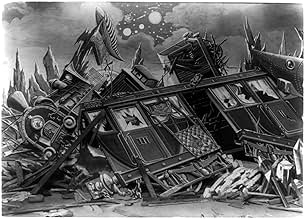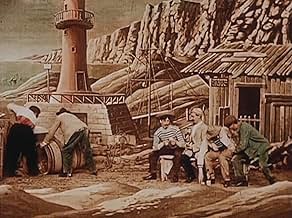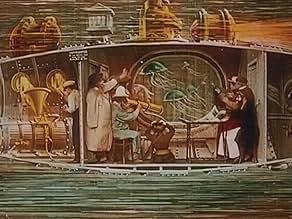Il viaggio attraverso l'impossibile
Titolo originale: Le voyage à travers l'impossible
VALUTAZIONE IMDb
7,4/10
4285
LA TUA VALUTAZIONE
Aggiungi una trama nella tua linguaUsing every known means of transportation, several savants from the Geographic Society undertake a journey through the Alps to the Sun which finishes under the sea.Using every known means of transportation, several savants from the Geographic Society undertake a journey through the Alps to the Sun which finishes under the sea.Using every known means of transportation, several savants from the Geographic Society undertake a journey through the Alps to the Sun which finishes under the sea.
- Regia
- Sceneggiatura
- Star
Fernande Albany
- Madame Latrouille
- (non citato nei titoli originali)
Jehanne d'Alcy
- Villager at seaport
- (non citato nei titoli originali)
May de Lavergne
- Nurse in Swiss hospital
- (non citato nei titoli originali)
Recensioni in evidenza
Having produced a blockbuster in 1903 in which a group of scientists journeyed to the moon, Melies tried to outdo himself the following year by having another group of manic scientists travel to the sun. He made this film longer and stencilled it in colour, and the outcome is quite astounding. To think that Melies was producing lengthy masterpieces like this while contemporary filmmakers were still experimenting with one-shot narratives goes to show how far ahead of his time Melies really was - which makes his downfall less than a decade later all the sadder. Melies fills the screen with colour with sets sometimes similar to the expressionist sets of the German masterpieces of the late teens and 20s, and fills it also with movement. Not one moment passes when there isn't something to look at. Although this film is not as widely known as Le Voyage dans la lune for my money it surpasses it in terms of exuberance and imagination.
What an interesting and unusual little feature this is - the combination of Méliès and Jules Verne always produces something worth seeing, and this one is based on one of Verne's most fantastical ideas. It follows a group of scientists and scholars on a very fanciful trip that uses every imaginable form of conveyance, and the story gives Méliès all kinds of opportunities for his trademark visual effects.
Each scene is packed with details, so much so that you cannot even catch it all in one viewing. It is also color-tinted in many places, which adds even more to the effect. The story is just wild, and is less plausible than many Verne stories, but that does not detract from it as entertainment. Méliès even tosses in a little slapstick, which is not too bad for its time. It is similar to, and just a cut below, his film of Verne's "Trip to the Moon", and anyone who enjoyed that classic should also like this one.
Each scene is packed with details, so much so that you cannot even catch it all in one viewing. It is also color-tinted in many places, which adds even more to the effect. The story is just wild, and is less plausible than many Verne stories, but that does not detract from it as entertainment. Méliès even tosses in a little slapstick, which is not too bad for its time. It is similar to, and just a cut below, his film of Verne's "Trip to the Moon", and anyone who enjoyed that classic should also like this one.
Director Georges Méliès was an absolutely brilliant early filmmaker and innovator. His camera tricks, use of a complex plot and sets, and fun-loving fantasy elements in his films made him the greatest film maker of his day. While I recently read that THE GREAT TRAIN ROBBERY (from Edison Inc.) was the "first full-length film", this simply isn't true, as Méliès' LE VOYAGE DANS LE LUNE (1902) preceded it and was a much more complex film--featuring amazing sets and lots of laughs as a group of scientists take a trip to the moon and meet the evil moon men! Only a year later, in an attempt to outdo his previous success, Méliès made this film about another group of wacky scientists who take a trip to the Sun as well as under the sea!! And, while the original film was a very long 14 minutes (that WAS full-length in its day), this one is 20--making it probably the longest film of its day.
While the new film is obviously strongly derived from the previous Méliès epic, compared to all other films of the day it is still brilliant and not even close to being matched. BUT, my score of 9 is more a way to indicate that it isn't quite as good as his film about the Moon. But, it is still very, very watchable and cute even today (something that can't be said of most other films of the age).
If you want to see this film online, go to Google and type in "Méliès" and then click the video button for a long list of his films that are viewable without special software.
While the new film is obviously strongly derived from the previous Méliès epic, compared to all other films of the day it is still brilliant and not even close to being matched. BUT, my score of 9 is more a way to indicate that it isn't quite as good as his film about the Moon. But, it is still very, very watchable and cute even today (something that can't be said of most other films of the age).
If you want to see this film online, go to Google and type in "Méliès" and then click the video button for a long list of his films that are viewable without special software.
Anybody who's seen Melies' "A Trip to the Moon" should certainly watch this. It not only surpasses the run time of the earlier film, (resulting in a 20 minute production which was amazing for its time), it is visually astounding and fantastic. Even though Melies had already indulged in multi-scene spectacles by this time, this was without a doubt the "Intolerance" of its day. Visual effects, nice color, beautiful sets...wow.
Many people have been calling this a sequel to "A Trip to the Moon" and I can see why they're saying that, because it is yet again a sci-fi topic. Instead of the moon, however, the scientists here go to the sun. There's tons of build-up too. First, they have to build the means of transportation (a train). Then, they go on this huge journey through the Swiss landscape. Then, their car gets busted and they have to spend days in the hospital. Obviously, Melies was more or less padding it out with all this build-up, but with all the action and detail put into each scene, there is plenty to see.
Melies obviously had an imagination. Not only had anybody ever gone to the moon by 1902, ANY sort of space travel was unheard of. Thus, even now we realize how utterly impossible it is to go to the sun (through the mouth, no less). But Melies was all about creating the impossible. This movie is such a visual treat that even people today could be entertained.
Also, it can be noted a supplemental section to this was made, where Crazyloff manages to recover the equipment lost in the sun by using a gigantic magnet to pull it all back to earth. It is unknown whether this section has survived, as John Frazer claims to have once inspected a print, while Malthete lists the short as lost.
Many people have been calling this a sequel to "A Trip to the Moon" and I can see why they're saying that, because it is yet again a sci-fi topic. Instead of the moon, however, the scientists here go to the sun. There's tons of build-up too. First, they have to build the means of transportation (a train). Then, they go on this huge journey through the Swiss landscape. Then, their car gets busted and they have to spend days in the hospital. Obviously, Melies was more or less padding it out with all this build-up, but with all the action and detail put into each scene, there is plenty to see.
Melies obviously had an imagination. Not only had anybody ever gone to the moon by 1902, ANY sort of space travel was unheard of. Thus, even now we realize how utterly impossible it is to go to the sun (through the mouth, no less). But Melies was all about creating the impossible. This movie is such a visual treat that even people today could be entertained.
Also, it can be noted a supplemental section to this was made, where Crazyloff manages to recover the equipment lost in the sun by using a gigantic magnet to pull it all back to earth. It is unknown whether this section has survived, as John Frazer claims to have once inspected a print, while Malthete lists the short as lost.
As many others have noted, "The Impossible Voyage" essentially follows the same adventure structure as Méliès's earlier and most popular film, "Le Voyage dans la lune" (1902). They are, after all, both based on works by Jules Verne and Adolphe Dennery. "The Impossible Voyage", however, is more elaborate and nearly or about twice as long--especially with the additional couple minutes that were available as an extended ending to exhibitors at extra cost (this ending hasn't been included on the Image Entertainment and Kino releases, but has been recently rediscovered and may be released on the upcoming Flicker Alley release). According to historian John Frazer, it cost 37,500 francs ($7,500) to make. "The Impossible Voyage" is also more chaotic, or anarchic--lampooning science and the adventures of science fiction to far greater extent. Whereas in "Le Voyage dans la lune", there was a clear journey executed in a rather concise manner, "The Impossible Voyage", instead, follows a group from The Institute of Incoherent Geography, led by an engineer Mabouloff (which translates as "Scatterbrains" and is played by Méliès), and the journey is, indeed, incoherent at times and certainly not concisely executed. On their trip, they crash their automobile (and there seems to be no reason they were even using it) in the mountains and spend some time in a hospital. They also become frozen inside a refrigerator while on the Sun. Furthermore, a journey to the Sun is obviously absurd in itself, unlike that to the Moon, which wasn't too far-fetched to the imagination even in 1902.
The overall result of this is mixed. On the one hand, it's an ambitious and entertaining film for 1904; on the other hand, the increased emphasis on chaos and satire here over that in "Le Voyage dans la lune" dissolves some of the narrative structure and continuity, especially in how it elongates the picture. Additionally, I can only appreciate the theatrical shot-scene, tableau style of Méliès's narratives in limited amounts. The fallacy of attempting to make cinema an extension of theatre, which was one of Méliès's stated goals, was fully exposed as a travesty with the early feature-length films (for example, "Queen Elizabeth" (Les Amours de la reine Élisabeth) (1912)) that were theatrical dramas rather than fantasies with spectacular theatrical effects. It's also not often acknowledged that filmmaker contemporaries of Méliès were already introducing and experimenting with the cinematic techniques of scene dissection, continuity editing and different camera positions. George Albert Smith, whom Méliès had even had correspondence with, was probably at the forefront of early pioneers in this respect, but also by the mid to late 1900s, the Vitagraph and Pathé companies were already employing crosscutting. Later, Méliès was also a contemporary of D.W. Griffith. Thus, I can't give Méliès a total pass because of his era. Yet, for its time and for what it is, "The Impossible Voyage" remains a somewhat entertaining and amusing film to this day, although I rank it lower than "Le Voyage dans la lune" and even some of his other fantasies, such as "Bluebeard" (1901) and "Kingdom of the Fairies" (1903).
On a further note, at this time--in the era of fairground exhibition of cinema--extra-filmic lecturers, or narrators, would aid audiences in following these new complex narrative films, or provide supplemental information to them. Méliès wrote narration to his story films, such as "The Impossible Voyage", for this purpose. Méliès also offered most of his films in hand-colored versions, for which exhibitors would have to pay an extra price (to give some credit, a team of women headed by a Mrs. Thullier hand colored most of them). Fortunately, and unlike some of his other films, "The Impossible Voyage" is generally available today in a hand-colored version with narration. It's helpful, and it works against some of the other limits of the film. Of the narration, however, it's also another example of the primitiveness of Méliès's films; it may be seen as an admission of their lack of cinematic storytelling and self-contained narration (or, as historian Noël Burch would say, it's "non-closed").
The overall result of this is mixed. On the one hand, it's an ambitious and entertaining film for 1904; on the other hand, the increased emphasis on chaos and satire here over that in "Le Voyage dans la lune" dissolves some of the narrative structure and continuity, especially in how it elongates the picture. Additionally, I can only appreciate the theatrical shot-scene, tableau style of Méliès's narratives in limited amounts. The fallacy of attempting to make cinema an extension of theatre, which was one of Méliès's stated goals, was fully exposed as a travesty with the early feature-length films (for example, "Queen Elizabeth" (Les Amours de la reine Élisabeth) (1912)) that were theatrical dramas rather than fantasies with spectacular theatrical effects. It's also not often acknowledged that filmmaker contemporaries of Méliès were already introducing and experimenting with the cinematic techniques of scene dissection, continuity editing and different camera positions. George Albert Smith, whom Méliès had even had correspondence with, was probably at the forefront of early pioneers in this respect, but also by the mid to late 1900s, the Vitagraph and Pathé companies were already employing crosscutting. Later, Méliès was also a contemporary of D.W. Griffith. Thus, I can't give Méliès a total pass because of his era. Yet, for its time and for what it is, "The Impossible Voyage" remains a somewhat entertaining and amusing film to this day, although I rank it lower than "Le Voyage dans la lune" and even some of his other fantasies, such as "Bluebeard" (1901) and "Kingdom of the Fairies" (1903).
On a further note, at this time--in the era of fairground exhibition of cinema--extra-filmic lecturers, or narrators, would aid audiences in following these new complex narrative films, or provide supplemental information to them. Méliès wrote narration to his story films, such as "The Impossible Voyage", for this purpose. Méliès also offered most of his films in hand-colored versions, for which exhibitors would have to pay an extra price (to give some credit, a team of women headed by a Mrs. Thullier hand colored most of them). Fortunately, and unlike some of his other films, "The Impossible Voyage" is generally available today in a hand-colored version with narration. It's helpful, and it works against some of the other limits of the film. Of the narration, however, it's also another example of the primitiveness of Méliès's films; it may be seen as an admission of their lack of cinematic storytelling and self-contained narration (or, as historian Noël Burch would say, it's "non-closed").
Lo sapevi?
- QuizIncluded in the "Georges Melies: First Wizard of Cinema (1896-1913)" DVD collection, released by Flicker Alley.
- BlooperFor a few seconds, a pole can clearly be seen holding the anthropomorphic sun up.
- Versioni alternativeAlso available in a computer colorized version.
- ConnessioniFeatured in Karl May (1974)
I più visti
Accedi per valutare e creare un elenco di titoli salvati per ottenere consigli personalizzati
Dettagli
- Data di uscita
- Paese di origine
- Lingue
- Celebre anche come
- An Impossible Voyage
- Luoghi delle riprese
- Aziende produttrici
- Vedi altri crediti dell’azienda su IMDbPro
Botteghino
- Budget
- 37.500 FRF (previsto)
- Tempo di esecuzione
- 24min
- Colore
- Mix di suoni
- Proporzioni
- 1.33 : 1
Contribuisci a questa pagina
Suggerisci una modifica o aggiungi i contenuti mancanti









